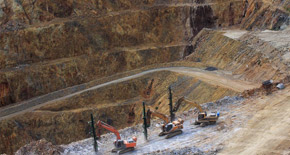EsT: how this technology is revolutionizing the world of underground detection.
An insightful article on EsT technology developed by Gianluca Paesanti, GPR Product Manager at IDS GeoRadar.

EsT: how this technology is revolutionizing the world of underground detection.
Ground Penetrating Radar is one of the most reliable instruments for obtaining intricate 2D and 3D details on underground utilities like gas pipes and electric cables, thus facilitating safer construction and pillar placement. GPR system is becoming an ever-present part of utility repair and maintenance, civil engineering, and other sectors where the reconstruction of the underground assets network ensures safer excavation and prevents accidental damage. In fact, amongst the various state-of-the-art methods available, it is a non-invasive technique capable of accurately locating both metallic and nonmetallic buried objects.
More and more contractors and pipe network owners see the value and increase in productivity provided by the usage of Ground Penetrating Radar systems in their activities. Obtaining a clear overview of the underground assets, as the digital utility network models, is an important value for the company which can minimize the possibility of striking pipes during the excavation and resulting costs.
This article will explore the advantages of IDS GeoRadar's revolutionary EsT technology, supported by Stream DP and Chaser XR. This cutting-edge Technology takes GPR performance to a whole new level, making utility mapping faster and more accurate than ever before.
The GPR technology: limits and challenges.
IDS GeoRadar has pioneered Ground Penetrating Radar research since the early 1990s and today is one of the largest global manufacturers of GPR products. IDS GeoRadar develops several GPR systems suitable for a wide range of applications, ranging from deep underground detection to utility mapping, road and railway assessment, structure detection, etc. The deep knowledge of Radar technology pushed us to the frontiers of the technology to overcome the limits posed by the GPR architectures developed so far.
Currently, technologies extend the dynamic range by stacking traces and then lowering the noise level to increase penetration depth. It improves penetration depth, but it does not solve one of the main limitations of current technology: penetration depth together with resolution.
With current GPR technologies on the market, to reliably detect all targets within a range of 0-4 m, it is necessary to use different antennas: the high-frequency antenna to get detailed information on the shallow side and the low-frequency antenna to detect the side of deeper targets. This is the reason why all GPR manufacturers provide different radars with different frequencies to meet all customer needs.
The dimensional constraints given by this architecture influence the design of the radiating element, implying a working bandwidth located in the UHF band, thus providing a reduced investigation depth.
IDS GeoRadar has invested heavily in research and development to create the patented EsT Technology. This new technology is designed to overcome the depth limitations of existing UHF Ground Penetrating Radar (GPR) systems used for underground utility mapping. EsT is implemented in two recently released instruments: Stream DP and Chaser XR.
EsT, a true revolution technology in underground investigation.
Radar dynamic range is the key feature related to GPR sensitivity to low amplitude signals, coming from weak and deep targets. It is given by the relation between the maximum signal level the GPR can receive and the minimum noise level. Assuming that the internal receiver noise figure is negligible with respect to external noise sources, considered in the equivalent temperature of the GPR antenna as white noise, dynamic range can be expressed only by the averaging factor (stacking) and the receiver architecture, where Effective Number of Bits of A/D circuitry plays a key role.
Standard GPR architecture exploits the stroboscopic principle to sample radar signals with equivalent frequencies of some GHz while maintaining enough ENOB on the A/D sampling circuitry to achieve a proper Dynamic Range.
Unfortunately, this technique implies a noise whitening, due to several folding of spectral noise contributions determined by using stroboscopic sampling frequency significantly lower than real system bandwidth.
Fig. 1 - Power spectrum of external noise collected through GPR receiving antenna. The presence of narrowband interferences like FM broadcast (88-108 MHz) as well as other noise contributions is evident.
The EsT Technology GPR units – Stream DP and Chaser XR – are capable of mitigating noise contributions as they are received, thus resulting in a greater extension of the dynamic range extension, greater than any extension achievable just through intensive data stacking.
Fig.2 - Comparison of radargrams obtained with standard stroboscopic sampling (left) and EsT (right), over the same site.
The increase in penetration depth is shown in Figure 2, where two data were collected in the same test site and, more importantly, at the same acquisition speed. The relevant noise floor of the data collected with the EsT Technology is about 25 dB w.r.t lower than the strobe sampled data.
Fig. 3 - Average Power of standard technology (red curve) vs EsT Technology (blue curve). Data was collected on the same site under the same conditions.
Moreover, the overall system dynamic range can then be increased by performing additional data stacking thanks to the performed noise whitening as a result of the rejection of main noise contributions. Important improvements with respect to standard stroboscopic sampling technology have also been noted in the frequency content of the sampled signals.
The extended dynamic range now allows us to get on the same radar trace echoes from shallow reflectors (i.e. less than 50cm) and echoes from deeper reflectors (i.e. greater than 2m).
Products supporting EsT.
EsT is the innovative technology currently integrated in two of the latest products introduced in the Hexagon Detection Portfolio - Stream DP and Chaser XR - to meet all subsurface mapping needs.
Stream DP is a top-performing tool for underground surveys; this state-of-the-art GPR system detects hidden underground features with a higher penetration depth compared to any other solution available on the market and facilitates the creation of accurate 2D and 3D maps of the underground surface, ensuring precise operations and the safety of field personnel.
Stream DP’s main features are:
• A 30 multichannel array solution
• Polarization: Configuration HH and VV
• UHF working frequency
• High data density
• Compact size116x82 cm
Surveys over large areas are facilitated by the possibility to tow the device with a small vehicle, allowing a further increase in productivity without compromising data quality.
Discover more on Stream DP.
Chaser XR is the powerful GPR solution setting a new standard in subsurface investigation and expanding the power of EsT patented technology to the world of geophysical surveying.
It is an All-in-One GPR antenna designed to cover all traditional frequency ranges for a wider range of applications: from environmental assessment to archaeological research to manmade structure investigations.
Chaser XR’s main features are:
- Extended bandwidth 80Mhz-1500Mhz
- Polarization: Configuration HH and VV
- UHF working frequency
- Compact size 41x41x19 cm
- Lightweight: 4.8Kg
EsT Technology on-field experience: Utility Mapping and Subsurface Profiling.
The Examples reported below highlight the significant results - compared to other current available technologies - that Est allows to obtain through its performance:
EsT Technology is capable of providing superior performance compared to current technologies on the market, both in terms of resolution and penetration depth.
Thanks to this technology, they were able to obtain results previously considered impossible: a 40%-60% greater penetration depth and an incredible level of detail.
EsT Technology Main Benefits.
In addition to the optimum data quality performance, EsT allows to feature unique characteristics to the IDS GeoRadar products:
- Maximized Detection
The best noise rejection obtained with EsT, to detect all the targets in the environment area, maximizing the detection compared to the other GPR systems.
- Easier Management
With equal central frequency, EsT technology allows to go deeper, making visible targets reached normally by antennas with a lower central frequency. This benefit obtainable thanks to EsT Technology means that, for the same depth of investigation, users can use smaller and lighter antennas, which drastically simplify field operations as well as make acquisition operations less tiring.
- Lower Initial Investment
With GPR Standard Technology, users need to purchase and manage more than one antenna to cover at the best all the applications. The extended bandwidth reached thanks to the EsT Technology, allows to drastically reduce the items needed, and so also the initial investment as well as the maintenance costs. For instance, Chaser XR can be used for all the typical applications in a range of 80Mhz-1500Mhz instead of the competitors’ solutions - three, four, or five antennas shall be purchased.
- Increased productivity.
Reduced weight and dimension, unparalleled data quality, and the extended depth of investigation make productivity achievable by the system leveraging the EsT Technology unmatchable.
- Low time and money for the field activity and radar data interpretation.
One scan is enough to detect all the targets in the inspection range while the clearest radar data allows to easily analyze and interpret data, speeding up the post-processing data interpretation phase.
All the benefits listed are transversal to all the possible applications where the ground penetrating radar can be used.
Final Conclusions
The use of EsT technology in Ground Penetrating Radar market brings real benefits for surveyors. EsT makes the asset detection easier, faster, and more accurate across all the possible applications that GPR systems can cover: from utility detection to archeological investigation.
All on-field users who tested the devices implementing EsT, were happily surprised in experiencing the superior data quality that EsT Technology can provide compared to other technologies available on the market. EsT allows for no compromise between depth and resolution, providing extended depth range and ultra high-resolution.
EsT technology introduces a major improvement in GPR technology, not only in terms of design - with Stream DP and Chaser XR devices - but more importantly from a technological point of view; this revolutionary technology offers an important set of innovative features that both basic and professionals users can benefit from mastering the unprecedented amount of data acquired.
Gianluca Paesanti
GPR Product Manager
IDS GeoRadar part of Hexagon































